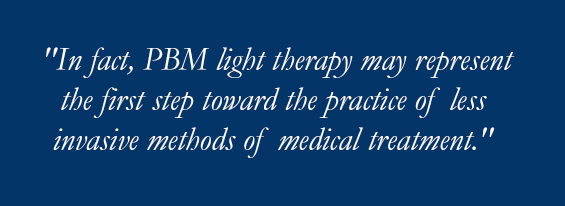Water and sun—its confluence draws us in. Think of standing near an ocean. There’s something about it that’s numinous, preternatural. Perhaps we can sense there’s more going on than just immense landscape and sunlight. It’s what occurs when light interacts with water. There’s something happening that’s life giving, restorative. It’s long been known that light can heal—and a new body of medical research seeks to harness this power.
“Water represents ∼70% by mass of an adult human body, or nearly 99% of total molecules by number, given water’s low molecular weight.” From this basic premise, researchers have discovered that certain wavelengths of light can be curative. The technique is called photobiomodulation (PBM), and it holds promise as an emerging treatment for traumatic brain injury as well as other serious conditions.
A recent article states: “Many investigators believe that PBM for brain disorders will become one of the most important medical applications of light therapy in the coming years and decades.” Another article suggests an even wider range for its use and application: “We propose that progress will lead to the imminent inception of PBM therapy as a mainstream treatment for multiple complex diseases…”
What is photobiomodulation? It’s a technique that uses near-infrared (NIR) wavelengths of light to heal. “NIR wavelengths (800–900 nm) can penetrate through scalp and skull (2–3%, ∼1 cm). These NIR wavelengths have the potential to improve the subnormal, cellular activity of compromised brain tissue by increasing adenosine triphosphate (ATP) production in the mitochondria, and increasing regional cerebral blood flow.”
One article describes improvement after PBM treatment in two patients with traumatic brain injury: “In the first case study the patient reported that she could concentrate on tasks for a longer period of time (the time able to work at a computer increased from 30 min to 3 h). She had a better ability to remember what she read…The second patient had statistically significant improvements compared to prior neuropsychological tests after 9 months of treatment.” Improved sleep and cognition, fewer PTSD symptoms, and higher levels of mental functioning in performing activities of daily living—these were seen in brain injured patients after PBM treatment.
It should not be surprising that water and light can combine to heal and restore health, but what is surprising is its continued efficacy over time. “Most authors suggest that the beneficial effects of tPBM on the brain can be explained by increases in cerebral blood flow, greater oxygen availability and oxygen consumption, improved ATP production and mitochondrial activity. However there are many reports that a brief exposure to light (especially in the case of experimental animals that have suffered some kind of acute injury or traumatic insult) can have effects lasting days, weeks or even months. This long-lasting effect of light can only be explained by activation of signaling pathways and transcription factors that cause changes in protein expression that last for some considerable time.”
 For patients with traumatic brain injury, PBM is currently not widely utilized, but in the coming years this may change. In fact, PBM light therapy may represent the first step toward the practice of less invasive methods of medical treatment. “Concurrently with the United Nations’ declaration of 2015 as the year of light and light-based technologies, PBM therapy stands at the brink of delivering a new generation of treatments for complex diseases. New PBM therapies will preserve quality of life and raise standard of care in an efficient and cost-efficient manner. This will particularly benefit the most vulnerable demographic sectors, such as the elderly and the poor, and reduce the strain of growing healthcare costs in both industrialized and developing countries. We propose that such developments and their imminent impact represent a paradigm shift or “quantum leap” in PBM therapy and medicine at large.”
For patients with traumatic brain injury, PBM is currently not widely utilized, but in the coming years this may change. In fact, PBM light therapy may represent the first step toward the practice of less invasive methods of medical treatment. “Concurrently with the United Nations’ declaration of 2015 as the year of light and light-based technologies, PBM therapy stands at the brink of delivering a new generation of treatments for complex diseases. New PBM therapies will preserve quality of life and raise standard of care in an efficient and cost-efficient manner. This will particularly benefit the most vulnerable demographic sectors, such as the elderly and the poor, and reduce the strain of growing healthcare costs in both industrialized and developing countries. We propose that such developments and their imminent impact represent a paradigm shift or “quantum leap” in PBM therapy and medicine at large.”
All quotations from: Michael R. Hamblin, Shining Light on the Head: Photobiomodulation for Brain Disorders, BBA Clin 113-124 (2016 December 6); Margaret A. Naeser, Michael R. Hamblin, Traumatic Brain Injury, A Major Medical Problem That Could Be Treated Using Transcranial, Red/Near-Infrared LED Photobiomodulation, Photomed Laser Surg., 33(9) 443—446 (2015 September 1); Luis Santana-Blank, et al., “Quantum Leap” in Photobiomodulation Therapy Ushers in a New Generation of Light-Based Treatments for Cancer and Other Complex Diseases: Perspective and Mini-Review, Photomed Laser Surg. 34(3) 93-101 (March 1, 2016)




